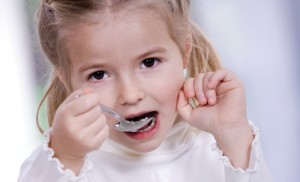A trip to the grocery store can be confusing when you’re trying to buy foods your kids will eat while trying to be health conscious, too. Understand label messaging so you can maintain a healthy menu at home.
BREAD: “Made with Whole Grains”
Whole grains are rich in protein, fiber and vitamins compared to refined grains. But “made with whole grains” is on everything now from snack chips to sugary cereals. Not exactly the best way to get your whole grains.
“The best way to add whole grains to your diet is to make simple changes to the foods you already make,” says Karah Stanley, a dietician with St. Elizabeth Physicians Weight Management Center. “For example, instead of white rice, use brown rice and rather than using white bread for your sandwiches, use whole wheat bread.” And be cautious, Stanley warns: just because something says multigrain does not mean it is a whole grain product. “Check out the Nutrition Facts Panel on the package to make sure that the first ingredient listed is whole wheat flour,” she advises.
CHICKEN NUGGETS: “Good Source of Protein”
While protein has its perks, kids typically get more than they need each day, Stanley says, unless of course, they’re following a vegetarian diet or just don’t care for meat.
“Protein can help keep hunger and cravings at bay when people are also keeping their carbohydrate intake at a reasonable level,” Stanley says. “Food marketers understand this, so they label the appropriate products as ‘good sources of protein’ so customers will be enticed to purchase them.”
JUICE: “100% Daily Value for Vitamin C”
Juice may seem to be a great way for your child to get his recommended intake of Vitamin C, but Stanley says kids ages 4 – 8 really only need 25 mg/day.
“It is relatively easy to reach this if your child’s diet includes a variety of fruits and veggies,” she says, adding that broccoli, strawberries, pineapple and cauliflower actually have more vitamin C than a medium orange. “The downside to using juice as a source for Vitamin C is that many juices have added sugars,” she says. “Also, even if there are no added sugars, the calories in juice really add up quickly — especially if the juice is being consumed in large quantities.
PACKAGED FRUIT: “Organic”
Yes, serve local and organic whenever possible. These are the foods that come from animals that aren’t given antibiotics or growth hormones, or are produced without most conventional fertilizers. Stanley says to keep in mind that there are three levels of organic. “100% Organic” (the product is entirely organic or made of only organic ingredients); “Organic” (at least 95% of the ingredients are organic); and “Made With Organic Ingredients” (at least 70% of the ingredients are certified organic).
SWEETENERS: “No High Fructose Corn Syrup”
Many manufacturers are phasing out high fructose corn syrup (HFCS) in foods, so the label “Now made with real sugar!” has popped up on products that had HFCS previously. Research is still mixed on whether you should worry about HFCS, Stanley says, but there’s clear evidence that too much of any added sugar can have negative effects on health in regards to weight gain, diabetes and heart disease.
“When it comes to sugar,” Stanley says, “the best advice is to cut back on added sugars of all kinds, wherever possible.”





